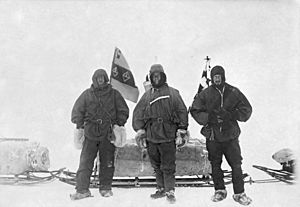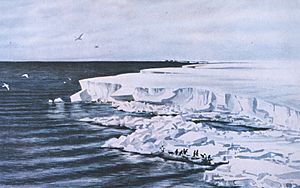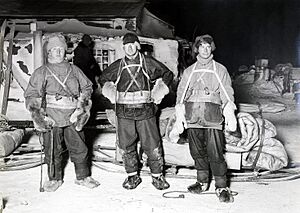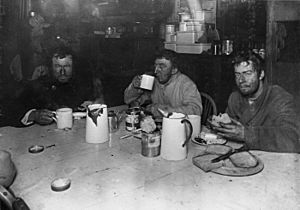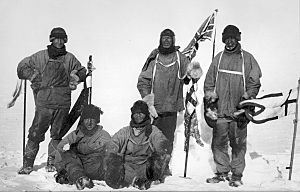Edward Wilson (explorer) facts for kids
Quick facts for kids
Edward Wilson
|
|
|---|---|
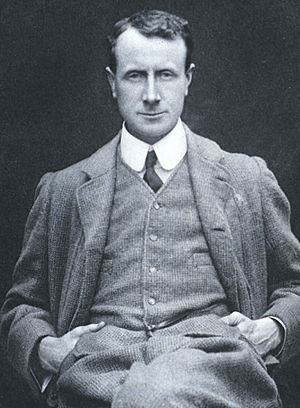 |
|
| Born |
Edward Adrian Wilson
23 July 1872 Cheltenham, England
|
| Died | 29 March 1912 (aged 39) Ross Ice Shelf, Antarctica
|
| Education | Cheltenham College |
| Alma mater |
|
| Occupation | Polar explorer, ornithologist, natural historian, physician, artist |
| Employer | Cheltenham General Hospital |
|
Expeditions
|
|
| Spouse(s) |
Oriana Fanny Souper
(m. 1901) |
| Awards |
|
Edward Adrian Wilson (born July 23, 1872 – died March 29, 1912) was an amazing English explorer who loved the coldest places on Earth! He was also a doctor, an artist, and a scientist who studied birds and nature. He is famous for his brave journeys to Antarctica with Captain Robert Falcon Scott.
Contents
Edward Wilson's Early Life
Edward Wilson was born in Cheltenham, England, on July 23, 1872. He was the fifth child in his family. From a young age, Edward loved nature and drawing. He spent a lot of time at his family's farm, drawing pictures of animals and plants.
When he was just nine years old, Edward told his parents he wanted to be a naturalist, someone who studies nature. His father helped him learn and draw even more. In 1891, Edward went to Gonville and Caius College, Cambridge, where he studied natural sciences. He did very well, earning a top degree in 1894.
While at college, Edward developed a strong Christian faith. He later studied to become a doctor at St George's Hospital Medical School in London. He even spent his free time helping people in poor areas of London. In 1898, he became very sick with a lung illness, probably from his mission work.
During his recovery, he spent months in Norway and Switzerland. He used this time to practice and improve his art skills. He became a qualified doctor in 1900. In 1901, he married Oriana Fanny Souper. Just three weeks later, he left for Antarctica on his first big adventure!
Adventures in Antarctica
The Discovery Expedition
From 1901 to 1904, Edward Wilson joined Captain Robert Falcon Scott's first trip to Antarctica, called the Discovery Expedition. He was the junior doctor, a zoologist (animal scientist), and the expedition's artist. They arrived in Antarctica in January 1902.
On November 2, 1902, Wilson, Scott, and Ernest Shackleton set off on a journey deeper into Antarctica than anyone had gone before. They had dogs to help pull their sleds, but the dogs' food went bad, and many dogs died. On December 31, they had to turn back. They had traveled about 480 kilometers (300 miles) further south than anyone before them!
The journey back was very hard. Shackleton became very sick, and Scott and Wilson struggled to get everyone back safely. After 93 days and traveling about 1,545 kilometers (960 miles), they finally reached their ship, the Discovery, in February 1903. Shackleton was sent home early because he was so ill. Later, Shackleton asked Wilson to join his own expedition, but Wilson stayed loyal to Scott and said no.
The Terra Nova Expedition
On June 15, 1910, Wilson set sail again for Antarctica on the Terra Nova. This was Captain Scott's final journey, and Wilson was the chief scientist. After many stops, the ship reached Cape Evans in Antarctica in January 1911.
The team built a base camp hut. They then started setting up supply stations for their long journey to the South Pole. One important supply point, called One Ton Depot, ended up being about 56 kilometers (35 miles) further north than planned. This small change would later become very important.
The Winter Journey
In the Antarctic winter of 1911, Wilson led a very difficult trip with Henry Robertson Bowers and Apsley Cherry-Garrard. They went to Cape Crozier to collect emperor penguin eggs for scientific study. This journey was about 97 kilometers (60 miles) long, made in almost complete darkness, with temperatures dropping to an incredible -57°C (-70°F)!
They were frozen and exhausted when they reached their goal. Then, a huge snowstorm hit. Their tent was ripped away by the wind, leaving them trapped in their sleeping bags under the snow for a day and a half! Luckily, they found their tent later. They successfully collected three eggs and returned to Cape Evans on August 1, 1911, after five weeks. Cherry-Garrard later wrote a famous book about this trip called The Worst Journey in the World.
Journey to the South Pole
On November 1, 14 men began the long trip to the South Pole. Seventy-nine days later, on January 18, 1912, Wilson was one of the five men who reached the Pole. But they found that the Norwegian explorer Roald Amundsen and his team had gotten there just five weeks earlier.
The journey back was incredibly difficult. The men were exhausted, didn't have enough nutrients in their food, and the weather was terrible. On February 17, one of the men, Edgar Evans, died. Then, on March 16, Captain Lawrence Oates, who had severe frostbite, bravely walked out of the tent into the blizzard, hoping to save his friends.
Wilson, Scott, and Bowers continued for three more days. But a blizzard stopped them on March 20. They were only about 18 kilometers (11 miles) from the 'One Ton' food depot that could have saved them. The storm lasted for days, longer than they had food or fuel. Too weak, cold, and hungry to go on, they died in their tent on or soon after March 29, 1912. They were still about 238 kilometers (148 miles) from their base camp.
A search party found their bodies in November 1912. They were buried where they lay, under a pile of snow, with a cross made from skis. When the news reached Britain, the whole country was sad.
The men on the expedition affectionately called Wilson "Uncle Bill." He was a trusted friend to many, known for his good judgment and kindness. Scott himself wrote, "Words must always fail me when I talk of Bill Wilson. I believe he really is the finest character I ever met."
Edward Wilson's Legacy
In 1913, after his death, Edward Wilson was given the Patron's Medal by the Royal Geographical Society for his important work in Antarctica. At his old college, Gonville and Caius College, Cambridge, the college flag that Wilson took to the South Pole is still kept safe.
You can see Wilson's artwork and other items related to him in several museums. The largest collection of his art is at the Scott Polar Research Institute in Cambridge. They have over 200 of his watercolors of British birds and 150 paintings he made in Antarctica. The museum also displays things like:
- A special flag his wife sewed for him, which he took on his sledging trips.
- A black flag from Amundsen's expedition that Wilson found near the South Pole.
- His Patron's Medal, awarded after his death.
- A candlestick he made from an old biscuit tin during the expedition.
Wilson's journal from the Terra Nova expedition is kept at the British Library, along with Captain Scott's diary. The Wilson art gallery and museum in Cheltenham also has many of his watercolors and drawings.
The RRS Discovery, the ship Wilson first sailed to Antarctica on, is now a museum in Dundee, Scotland, where visitors can explore it.
A statue of Edward Wilson stands in Cheltenham. It was created by Scott's wife, Kathleen Scott, and was unveiled in 1914. In 2013, the Cheltenham Art Gallery & Museum was renamed 'The Wilson' in his honor. There are also buildings and schools named after him, like the Edward Wilson Primary School in London.
Edward Wilson has been shown in movies and TV shows too! He was played by Harold Warrender in the 1948 film Scott of the Antarctic.
See also
 In Spanish: Edward Adrian Wilson para niños
In Spanish: Edward Adrian Wilson para niños


